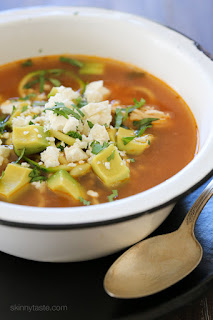My daughter recently gifted me an OXO Good Grips zoodle maker for Mother's Day, and it's been fun seeing how much butter, cheese and bacon I can combine with the tasty vegetable noodles. For dinner last night (see photo below), I sauteed the zoodles in butter and added bacon and Parmesan cheese.
Eager to find more uses for my new toy, this morning I searched online for some recipes using zoodles instead of pasta. Some of these recipes skimp on fat because of misguided perceptions perpetuated by old school media and registered dietitians that fat is bad for you; so I will just add more of the good stuff like avocado, cheese, etc. and use the full-fat version of any ingredients with the unfortunate modifer low- or non- before fat.
 |
| Chicken Zoodle Soup from skinnytaste |
 |
| Shrimp Florentine from Allrecipes |
This recipe for shrimp Florentine with zoodles is your basic scampi with spinach and zoodles. I'll probably increase the butter and add some fresh grated parmesan cheese.
 |
| Zucchini with Meat Sauce from Butter is Not a Carb |
What zoodle recipe sampler would be complete without a zoodles and meat sauce dish? This recipe includes mushrooms, but I may also other veggies hanging out in the crisper and maybe some bacon and cheese.
This is the zoodle maker I received for Mother's Day. It's technically called an OXO Good Grips 3-Blade Spiralizer with StrongHold Suction. It couldn't be easier to operate, clean and store. The color coded blades nest in an adorable storage box when not in use. And, unlike the smaller hand held models like the Veggetti, this spiralizer yields minimal zucchini wastage.
 |
| My new zoodle maker is a snap to use. |

